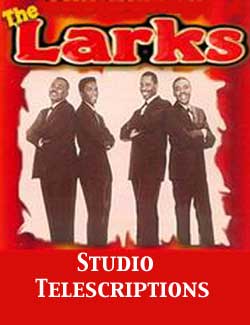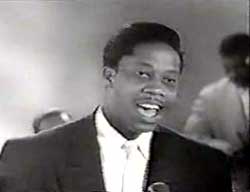 The Studio Films telescription of Danny Boy (1954) featuring The Larks is a remarkable performance.
The Studio Films telescription of Danny Boy (1954) featuring The Larks is a remarkable performance.
This telescription was stitched into the compilation of Snader & Studio telescriptions & syndicated to television as Showtime at the Apollo: All Star Revue (1955), though the pretence of a live concert at the Apollo was just that, a pretence.
The name of the Larks was a natural, being contemporary to the Orioles, the Ravens, the Orioles, the Cardinoles, the Robins, the Swallows, the Crows, & the Flamingos.
For a song that is traditionally sung by Irish tenors, we get instead the booming base of an early doowop group, & it's simply tremendous.
Less than halfway through Danny Boy, tenor Gene Mumford takes over the lead vocal, so that it comes closer to sounding like the traditional tenor rendering. But the "doo doo doo-doo-doo weee" harmonies keep it very doowoppy rhythm & blues, with a rather Ink Spots style conclusion.
The film's framing of the four-man group is strange because for most of the number it looks like there are only three Larks. The fourth is mostly only seen as the edge of a shoulder to the far left of the screen, until more than halfway through the camera backs up & shows them all.
In the background is the Paul Williams band, including Glenn Burgess at piano, who mostly we see only as a tapping toe under the piano bench.
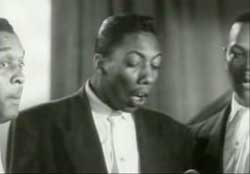 The Paul Williams band is backing up The Larks in all their Studio telescriptions, which were made on the same day at the Studio Films sound stage in Manhattan, with Willie Bryant to introduce their numbers.
The Paul Williams band is backing up The Larks in all their Studio telescriptions, which were made on the same day at the Studio Films sound stage in Manhattan, with Willie Bryant to introduce their numbers.
Hawley was the emcee at the Apollo Theater, & the 1954 telescriptions were going to be spliced together with some 1950 through 1952 Snader telescriptions, and mixed up with a few comedy acts, & fobbed off as a series of concerts at the Apollo Theater.
This telescript mini-film was spliced into Showtime at the Apollo: Harlem Variety Review (1955). There were thirteen half-hour fake-Apollo concerts syndicated to television in 1955, a chance for all of America to see some of the best black talent America possessed.
Hawley introduces The Larks on the telescription Without a Song, This number is closer to a swing number than their usual doowop harmonies.
It begins with an introductory lyric done by all four guys: "I got a song you got a song so let's sing owwwt." Then Gene Mumford takes the lead with back up from the rest singing totally different lyrics that comment on what Gene sings.
The base singer David "Boots" Bowers gets a lead for a few moments. In their dark suits & with their thrilling talent these guys exude classiness.
I hate to sound like an old biddy lamenting the good ol' days but can't help but notice sometimes that there was a time when it was hip to exude class, & I do like that better than today's tendency toward pimp & player.
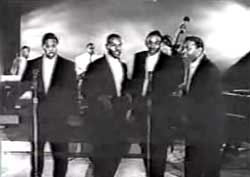 Hawley introduces the Larks for Margie (1954) as "not a double-barrel singing group, but a four-barrel singing group," so even for classy guys of another era it was already thought proper to describe them in terms that convey implications of armed & dangerous.
Hawley introduces the Larks for Margie (1954) as "not a double-barrel singing group, but a four-barrel singing group," so even for classy guys of another era it was already thought proper to describe them in terms that convey implications of armed & dangerous.
Orville Brooks sings the lead this time. The lyrics run: "Margie. I'm always thinking of you Margie/ I'll tell the world I love you so/ Don't forget your promise to me/ You know I brought you diamond bracelets & everything/ So, my little Margie..."
They've changed the lyrics a bit as in the Cab Calloway version he gets her a house & a diamond ring, vis, they got married. Kinda funny these guys didn't want to sing about getting married.
Written by Benny Davis, Con Conrad & J. Russel Robinson way back in the Roaring '20s, the Larks give it the fully updated doowop treatment & it's pretty nice. It actually fits neatly into the history & origins of doowop, because a version by Jimmy Lundford in 1938 in adding scat bits to the lyrics hit dead-onto "Oh bop a doo bop, Margie!"
Halfway through the Larks version, it swaps lead vocalists, & when Mumford takes over from Orville, it momentarily turns into a jump-jazz number, reinforced by a sax solo from the Paul Williams band behind them very much in the Louis Jordan vein.
The guys turn around to watch the sax, clapping their hands. They then return to the microphones for a big harmony close. Gene & Orville invest this one with great fun. And this one was spliced into Showtime at the Apollo: Beale Street Review (1955).
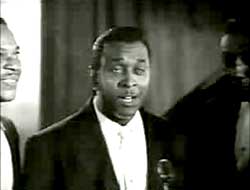 "And here they are, the Larks!" says Hawley very simply. Curtains part to reveal the Paul Williams band & out run the four harmony singers to sing about Shadrach (1954) & the King of Babylon, base vocalist Boots Bower taking the main lead.
"And here they are, the Larks!" says Hawley very simply. Curtains part to reveal the Paul Williams band & out run the four harmony singers to sing about Shadrach (1954) & the King of Babylon, base vocalist Boots Bower taking the main lead.
This is a great number & not so much early doowop as a throwback to the Delta Rhythm Boys or the Deep River Boys, revealing the important spiritual ingredient for the origins of secular harmony.
A good harmony group just can't screw this song up, but a great harmony group such as the Larks were can make it even greater than great. And the Larks give a transcendent rendition.
Besides Gene Mumford lead tenor & Boots Bowers bass, the other guys are Isaiah Bing second tenor & Orville Brooks baritone. This telescription ended up spliced into Showtime at the Apollo: Harlem Merry-Go-Round (1955).
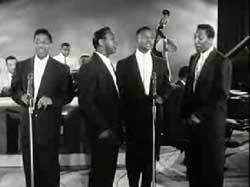 The World is Waiting for Sunrise (1954) was included in the theatrically released Rhythm & Blues Review (1955). The World is Waiting for Sunrise (1954) was included in the theatrically released Rhythm & Blues Review (1955).
This number was covered by many vocalists & musicians including Les Paul & Mary Ford, & Chet Atkins. For the Larks, it was harmonized very much in the manner of the Mills Brothers or Delta Rhythm Boys, a sound predating the doowop for which the Larks are best known.
They're not quite singing it a-capella because you can hear the piano keeping a steady beat & the bassist in the Paul Williams Band is helping, though the rest of the band is just sitting there in the background.
In July of '54 the Larks had sung this song on the Arthur Godfrey Talent Scout Show & won the competition, so the song was quickly put onto wax & released by Apollo Records while the iron was hot. It was out in August. The telescription being a genuine live performance is a distinct version.
There were two excellent vocal groups called The Larks, lending to a lot of confusion. Tenor Eugene Mumford joined the earlier, original Larks as the fifth member after they'd been around a few months. He wrote for the group "When I Leave These Prison Walls," not least because he'd just gotten out, & this was recorded in 1951.
Their biggest hit was "Reverie," but even that was more a critical than commercial hit. Without being on the R & B charts, it was hard to get the highest paying gigs, so the quintet broke up in 1952 having been together barely two years. All the members went on to successes in other groups.
Gene Mumford not long after founded the second harmony group with the name. His being in both groups lends doubly to confusion. Most historians of R & B or harmony groups prefer the original five Larks to the new quartet version which was together only in 1953-54. But the smaller legacy of Gene's group is so impressive that we can only lament they didn't stick together longer, to achieve more.
They recorded five telescriptiosn at the Studio Films soundstage in 1954. Their final record was issued in June 1955, but they had already broken up by then, over a misunderstanding, rumor, or actual problem that messed up an Apollo Theater booking.
So they just threw in the towel. When The World is Waiting for Sunrise reached the film theaters as part of Rhythm & Blues Review that December, by then the Larks no longer existed & could not take advantage of the potential boost for success.
copyright © by Paghat the Ratgirl
|
